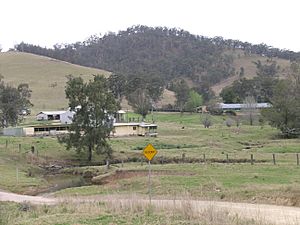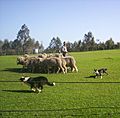Station (agriculture) facts for kids
A station is a very large farm in Australia and New Zealand. These huge properties are used for raising livestock, like cattle or sheep. The word "station" is used instead of "ranch" in these countries.
Contents
What Are Stations?
Stations are often found in remote areas, far from cities. They can be incredibly big, sometimes larger than some small countries! Because of their size, they need a lot of land for animals to graze. This land might be dry or have different types of plants.
Why Are Stations So Big?
The land in many parts of Australia and New Zealand is not very fertile. This means it cannot support many animals in a small area. To raise enough livestock, graziers need vast amounts of land. This is why stations are so much larger than typical farms in other parts of the world.
Life on a Station
Life on a station can be very different from living in a town or city. Stations are often isolated, meaning they are far away from other people and services.
Daily Activities
Workers on a station, called stockmen or stockwomen, spend their days looking after the animals. This includes:
- Moving herds of cattle or flocks of sheep
- Checking on the health of the animals
- Repairing fences
- Maintaining water sources like bores and dams
- Using horses or quad bikes to get around the vast property
Remote Living
Because stations are so remote, families living there often have to be self-sufficient. They might have their own power generators and rely on satellite internet. Children living on stations often learn through distance education, using computers and radio to connect with teachers. The Royal Flying Doctor Service is very important for medical help in these isolated areas.
Who Works on a Station?
The main person who owns or manages a station is called a grazier or a pastoralist. They are responsible for the entire operation.
Station Workers
Besides the grazier, many other people work on a station:
- Stockmen and Stockwomen: These are the main workers who handle the livestock. They are skilled at riding horses or driving vehicles to manage the animals.
- Cooks: On large stations, there might be a cook who prepares meals for all the workers.
- Mechanics: With so much machinery, a mechanic is often needed to keep vehicles and equipment running.
- Governesses or Tutors: For children on remote stations, a governess or tutor might live on the property to help with their schooling.
Types of Stations
Stations are usually named after the type of animal they raise.
Cattle Stations
These stations focus on raising cattle for beef. They are very common in the northern parts of Australia, where the climate is warmer. Cattle stations can be enormous, sometimes covering millions of acres.
Sheep Stations
Sheep stations raise sheep, mainly for their wool or for meat. These are more common in the cooler, southern parts of Australia and in New Zealand. Shearing sheep is a big event on these stations, often needing many extra workers called shearers.
Why Are Stations Important?
Stations play a vital role in the economies of Australia and New Zealand.
Food and Wool Production
They produce a huge amount of meat and wool that is used both locally and exported around the world. This helps feed many people and provides materials for clothing.
Cultural Significance
Stations are also a big part of the history and culture of these countries. They represent a unique way of life and the challenges of working with the land in vast, remote areas. The skills and traditions of stockmen and graziers are an important part of their heritage.
Related pages
Images for kids
-
Border Collie and a collie cross working sheep in Queensland
-
Noonkanbah woolshed, now a local community centre in Western Australia







